Best Places To Travel In Bhutan
1.Thimphu(Capital of Bhutan)
Thimphu(Bhutan)
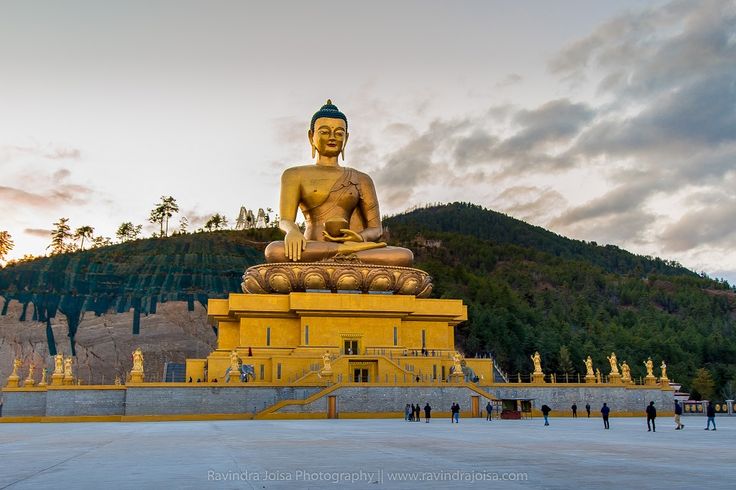
Thimphu
Thimphu, the capital of Bhutan, is a city where tradition and modernity coexist harmoniously. It is the political, economic, and cultural heart of Bhutan, known for its unique blend of ancient monasteries, traditional Bhutanese architecture, and contemporary developments. Thimphu is the only capital in the world without traffic lights, with policemen directing traffic at major intersections. The city hosts important landmarks like Tashichho Dzong, the seat of government, and the Memorial Chorten, a revered religious site. Surrounded by mountains and forests, Thimphu offers a serene environment with a deep connection to Bhutan’s spiritual and cultural heritage.
Buddha Dordenma
Buddha Dordenma is a majestic statue of Buddha Shakyamuni located atop a hill in the Kuenselphodrang Nature Park, overlooking Thimphu Valley. Standing at 169 feet (51.5 meters) tall, it is one of the largest Buddha statues in the world. The statue is made of bronze and gilded in gold, housing over 125,000 smaller Buddha statues inside it. Buddha Dordenma is not only a symbol of peace and prosperity but also offers panoramic views of the Thimphu Valley, making it a significant spiritual and tourist destination in Bhutan.
Best months to visit in Buddha Dordenma
March to May (Spring): During this time, the weather is pleasant with blooming flowers and clear skies, making it ideal for outdoor activities and sightseeing. The temperature is comfortable, ranging between 15°C to 25°C (59°F to 77°F).
September to November (Autumn): This is another excellent time to visit, as the monsoon rains have subsided, and the skies are clear, offering stunning views of the surrounding mountains. The temperature is cool and comfortable, making it perfect for exploring the area.
Open days and timing of Buddha Dordenma
Buddha Dordenma in Thimphu is generally open to visitors every day of the week. The typical visiting hours are:
- Open Days: Monday to Sunday (all days of the week)
- Timings: 9:00 AM to 5:00 PM
Ticket Buddha Dordenma
Visiting the Buddha Dordenma in Thimphu is **free of charge** There is no entry ticket required. This makes it an easily accessible site for both locals and tourists who wish to experience the grandeur of the statue and the serene surroundings.
Famous places of Bhutan
1. Kuenselphodrang Nature Park
- Surrounding the Buddha Dordenma, this park offers walking trails and beautiful natural scenery. It’s a great place for hiking and enjoying the tranquil environment.
2. Tashichho Dzong
- Located about 6-7 kilometers from Buddha Dordenma, Tashichho Dzong is a grand fortress and monastery that serves as the seat of Bhutan’s government and the central monastic body.
3. National Memorial Chorten
- Situated around 7-8 kilometers away, this large stupa is a popular religious site where locals gather for prayer and meditation. It’s a significant cultural landmark in Thimphu.
4. Changangkha Lhakhang
- A few kilometers from the Buddha Dordenma, this temple is perched on a hill and offers great views of Thimphu. It is a popular site for locals seeking blessings for their newborns.
5. Simply Bhutan Museum
- Located about 6 kilometers away, this museum provides a glimpse into Bhutanese culture and traditions, offering interactive exhibits, traditional food, and local handicrafts.
6. National Institute for Zorig Chusum
- Around 7 kilometers from Buddha Dordenma, this institute is also known as the School of Arts and Crafts, where you can observe students practicing traditional Bhutanese arts.
7. Thimphu Weekend Market
- About 7-8 kilometers away, the weekend market is a vibrant spot to experience local life, shop for fresh produce, and buy traditional Bhutanese crafts.
2.Paro
Paro(Bhutan)
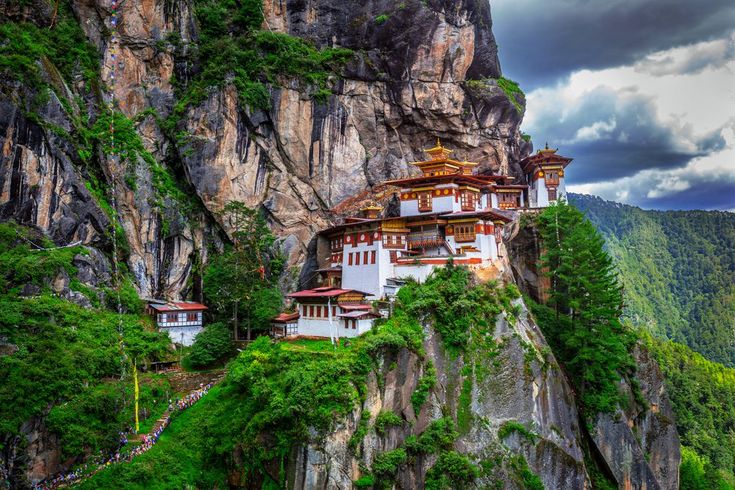
Paro(Bhutan)
Tiger’s Nest Monastery, known locally as Paro Taktsang, is a spectacular cliffside monastery perched 3,120 meters (10,230 feet) above sea level. It is one of Bhutan’s most iconic and revered landmarks, known for its breathtaking location on a steep granite cliff. The monastery, which was built in 1692, is linked to a famous legend that Guru Rinpoche (Padmasambhava) meditated here. The trek to the monastery is a memorable experience, offering stunning views of the surrounding landscape and an opportunity to explore its sacred halls and chapels.
Paro
Paro is a picturesque valley town in western Bhutan known for its rich cultural heritage and stunning natural beauty. It serves as the gateway to Bhutan’s most famous landmark, Tiger’s Nest Monastery. The town is home to notable sites such as Paro Dzong, a grand fortress-monastery, and the National Museum of Bhutan, housed in the historic Ta Dzong. The valley is dotted with traditional Bhutanese farmhouses and offers a serene environment perfect for exploring its cultural landmarks, beautiful landscapes, and traditional festivals.
Best months to visit in Paro(Bhutan)
March to May (Spring): During this period, the weather is mild and pleasant, with blooming flowers and clear skies, making the hike up to the monastery enjoyable. The temperatures range from 10°C to 20°C (50°F to 68°F), which is comfortable for trekking.
September to November (Autumn): This is another ideal time to visit, as the monsoon rains have ended, and the skies are clear, providing excellent views of the surrounding mountains. Temperatures are cool and comfortable, ranging from 10°C to 20°C (50°F to 68°F).
Open days and timing of Paro
Tiger’s Nest Monastery (Paro Taktsang) is generally open to visitors every day of the week. The typical visiting hours are:
- Open Days: Monday to Sunday (all days of the week)
- Timings: 8:00 AM to 1:00 PM and 2:00 PM to 5:00 PM
Ticket of Paro (Bhutan)
To visit Tiger’s Nest Monastery (Paro Taktsang), you need to purchase a ticket. The ticket prices are:
- Foreign Tourists: The entrance fee is approximately Nu 1,200 (about USD 10-12).
- Bhutanese and South Asian Nationals: Generally, there is no entry fee for Bhutanese and South Asian nationals, but it’s always good to check for any updates or changes.
Famous places of Bhutan
1. Paro Dzong (Rinpung Dzong)
- Description: Located about 10 kilometers (6 miles) from Tiger’s Nest, this grand fortress-monastery is a significant cultural and administrative center in Paro. It features impressive Bhutanese architecture and hosts the annual Paro Tsechu festival.
2. Kyichu Lhakhang
- Description: Approximately 8 kilometers (5 miles) from the monastery, this ancient temple is one of Bhutan’s oldest and most sacred sites. It’s known for its historical significance and beautiful religious art.
3. National Museum of Bhutan (Ta Dzong)
- Description: Situated around 7 kilometers (4.5 miles) from Tiger’s Nest, this museum offers a comprehensive overview of Bhutanese culture and history, housed in a former watchtower.
4. Drukgyel Dzong
- Description: Located about 15 kilometers (9 miles) from the monastery, this historic fortress was built to commemorate Bhutan’s victory over Tibetan invaders. Although partially in ruins, it provides stunning views and historical insights.
5. Chele La Pass
- Description: About 35 kilometers (22 miles) from Tiger’s Nest, this mountain pass offers spectacular views of the Himalayas and the Paro Valley. It’s a great spot for panoramic photography and enjoying high-altitude scenery.
6. Haa Valley
- Description: A bit farther from Paro, approximately 60 kilometers (37 miles) away, Haa Valley is known for its serene landscapes and traditional Bhutanese culture. It’s a lovely place for a day trip to experience rural Bhutan
3.Punakha Dzong
Punakha Dzong(Bhutan)
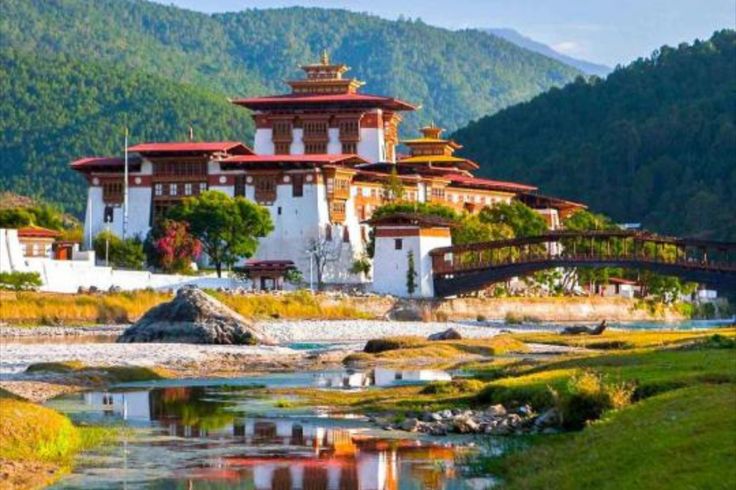
Punakha
Punakha, situated in central Bhutan, is known for its rich cultural heritage and picturesque surroundings. Once the capital of Bhutan, it remains a significant cultural and historical center. The town is characterized by its pleasant climate, fertile valley, and beautiful architecture. Besides the famous Punakha Dzong, visitors can explore other attractions such as the Chimi Lhakhang, renowned for its fertility blessings, and the scenic Punakha Suspension Bridge. The region offers a blend of historical significance, traditional Bhutanese culture, and stunning natural beauty, making it a captivating destination.
Punakha Dzong
Punakha Dzong, often hailed as one of Bhutan’s most magnificent dzongs, is strategically located at the confluence of the Pho Chhu (Father River) and Mo Chhu (Mother River). Constructed in 1637 by Zhabdrung Ngawang Namgyal, the dzong serves as both a religious and administrative center. Its stunning architecture, with elaborate woodwork and intricate murals, and its scenic setting against the backdrop of lush landscapes and the rivers make it a must-see landmark. The dzong is also renowned for hosting the annual Punakha Tsechu festival, which attracts numerous visitors and locals alike.
Best months to visit in Punakha
March to May (Spring): During this period, the weather is pleasant, with blooming flowers and clear skies. Temperatures are mild, making it ideal for exploring the dzong and the surrounding areas.
September to November (Autumn): This time offers clear skies and comfortable temperatures, following the monsoon season. The landscape is lush and green, and the air is crisp, providing excellent visibility and a pleasant experience for sightseeing.
Open days and timing of Punakha
Punakha Dzong is typically open to visitors every day of the week. The usual visiting hours are:
- Open Days: Monday to Sunday (all days of the week)
- Timings: 9:00 AM to 5:00 PM
Ticket of Panakha(Bhutan)
Visiting Punakha Dzong usually requires a ticket. The typical entrance fees are:
- Foreign Tourists: Approximately Nu 300 (about USD 2-3).
- Bhutanese Nationals: Generally, Bhutanese visitors do not need to pay an entry fee.
Famous places of Bhutan
1. Chimi Lhakhang
- Distance: About 10 kilometers (6 miles) from Punakha Dzong
- Highlights: Known as the “Fertility Temple,” this temple is dedicated to Lama Drukpa Kunley, also known as the “Divine Madman.” It’s a popular site for couples seeking blessings for fertility and offers scenic countryside views.
2. Punakha Suspension Bridge
- Distance: Approximately 7 kilometers (4.5 miles) from Punakha Dzong
- Highlights: One of the longest suspension bridges in Bhutan, it spans the Mo Chhu River and provides stunning views of the river and surrounding landscapes.
3. Khamsum Yulley Namgyal Chorten
- Distance: About 30 kilometers (19 miles) from Punakha Dzong
- Highlights: A beautiful stupa built by the Queen Mother to bring peace and harmony to the region. It’s situated on a hilltop and offers panoramic views.
4. Wangdue Phodrang Dzong
- Distance: Approximately 25 kilometers (15 miles) from Punakha Dzong
- Highlights: This dzong, though partially destroyed by fire in 2012, offers impressive views and historical significance. The site is currently undergoing reconstruction.
5. Talo Monastery
- Distance: Around 30 kilometers (19 miles) from Punakha Dzong
- Highlights: A serene and picturesque monastery known for its traditional architecture and scenic location. It’s a peaceful spot for reflection and exploration.
6. Dochu La Pass
- Distance: About 40 kilometers (25 miles) from Punakha Dzong
- Highlights: This mountain pass offers spectacular views of the Himalayan range and the surrounding valleys. It’s a great spot for panoramic photography and enjoying the natural beauty.
4.Bumthang
Bumthang(Bhutan)
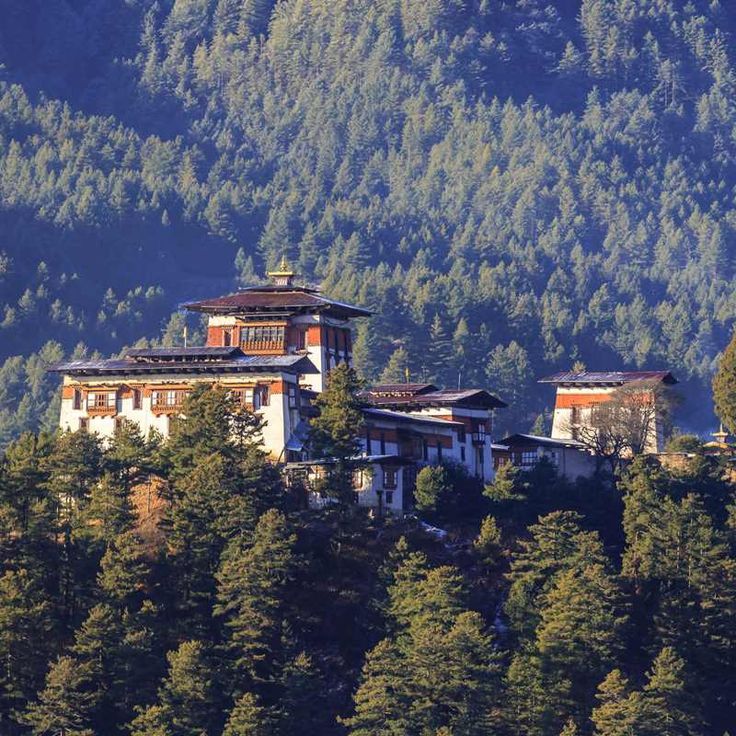
Bumthang
Bumthang, located in central Bhutan, is a culturally rich and historically significant district. It is often called the “cultural heartland” of Bhutan due to its many ancient temples and monasteries, including Jambay Lhakhang and Kurje Lhakhang. The region is known for its beautiful valleys, sacred sites, and vibrant festivals such as the Jambay Lhakhang Drup. Bumthang’s landscape is characterized by lush forests, fertile farmland, and pristine rivers, making it a picturesque destination that offers a deep connection to Bhutanese spirituality and tradition.
Bumthang Valley
Bumthang Valley, often referred to as the spiritual heartland of Bhutan, is a collection of four valleys—Chokhor, Tang, Ura, and Chhume—each offering unique landscapes and cultural experiences. The valley is known for its rolling green hills, traditional Bhutanese farmhouses, and a serene environment that invites exploration. Bumthang Valley is home to some of Bhutan’s most important and ancient monasteries, making it a key destination for those interested in Bhutanese culture and history. The region is also known for its apple orchards, dairy products, and the production of traditional Bhutanese textiles.
Best months to visit in Bumthang
March to May (Spring): During this time, the weather is mild and pleasant, with blooming flowers and vibrant green landscapes. Temperatures range from 8°C to 20°C (46°F to 68°F), making it an ideal time for outdoor activities and exploring the valley’s cultural sites.
September to November (Autumn): This season offers clear skies, crisp air, and stunning views of the surrounding mountains. The autumn months are perfect for trekking and experiencing the valley’s natural beauty, with temperatures ranging from 5°C to 18°C (41°F to 64°F).
Open days and timing Bumthang
- Jakar Dzong: Typically open daily from 9:00 AM to 5:00 PM.
- Kurje Lhakhang and Jambay Lhakhang: Usually open daily from 8:00 AM to 5:00 PM.
- Ogyen Choling Palace Museum: Open daily, but hours may vary, so it’s advisable to check locally.
Ticket of Bumthang
- Jakar Dzong, Kurje Lhakhang, and Jambay Lhakhang: These religious sites usually do not have an entrance fee for visitors.
- Ogyen Choling Palace Museum: There may be a small entrance fee for the museum, typically around Nu 150-200 (approximately USD 2-3) for foreign tourists.
Famous places of Bumthang
1. Mebar Tsho (Burning Lake)
- Distance: About 30 kilometers (19 miles) from Jakar town in Bumthang Valley
- Highlights: A sacred site where the revered Bhutanese saint Pema Lingpa is said to have discovered hidden treasures. The lake is known for its spiritual significance and scenic beauty.
2. Tang Valley
- Distance: Approximately 20 kilometers (12 miles) from Jakar
- Highlights: A picturesque valley known for its peaceful atmosphere and traditional villages. Tang Valley is home to Ogyen Choling Palace Museum, which offers insights into Bhutanese aristocratic life.
3. Ura Valley
- Distance: About 50 kilometers (31 miles) from Jakar
- Highlights: Known for its serene environment and charming village life, Ura Valley is often described as one of the most beautiful valleys in Bhutan. It’s a great spot for hiking and experiencing traditional Bhutanese culture.
4. Chokhor Valley
- Distance: Located within Bumthang, Chokhor Valley is the main valley of Bumthang District.
- Highlights: This valley is home to several important temples and monasteries, including Jambay Lhakhang, Kurje Lhakhang, and Tamshing Lhakhang. It’s a central area for exploring Bumthang’s rich cultural heritage.
5. Chhume Valley
- Distance: Approximately 25 kilometers (16 miles) from Jakar
- Highlights: Known for its traditional Bhutanese woolen textile production, particularly the famous Yathra fabric. Visitors can explore local weaving shops and purchase handmade textiles.
6. Tamshing Lhakhang
- Distance: About 5 kilometers (3 miles) from Jakar
- Highlights: A historic temple founded by Pema Lingpa in 1501. It’s known for its ancient murals and the sacred chain mail vest used in traditional rituals.
7. Jakar Dzong
- Distance: Located in Jakar, the main town of Bumthang Valley
- Highlights: Also known as the “Castle of the White Bird,” Jakar Dzong offers stunning views of the valley and is a significant cultural and administrative center.
5.Phobjikha Valley
Phobjikha Valley (Bhutan)
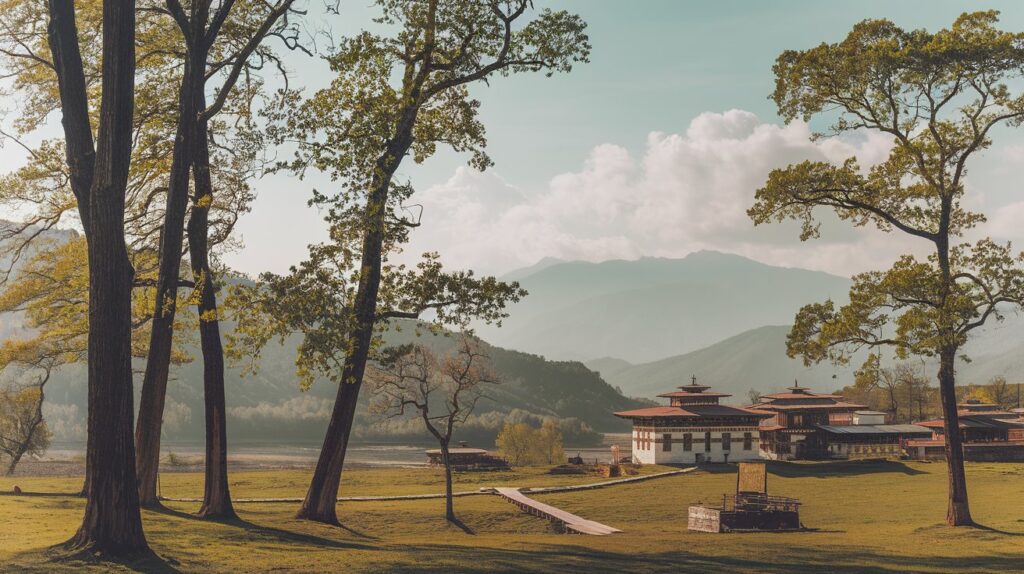
Phobjikha Valley
Phobjikha Valley, often referred to as the “Valley of the Black-Necked Cranes,” is a stunning glacial valley located in the central part of Bhutan, within the Wangdue Phodrang District. It is renowned for its scenic beauty, with rolling green hills, vast meadows, and serene marshlands. The valley is a designated conservation area and is famous as the winter home of the endangered black-necked cranes, which migrate here from Tibet between late October and early March.
The valley is also home to the charming Gangtey Monastery, a significant Nyingmapa monastery that overlooks the valley. Phobjikha is an ideal destination for nature lovers and those seeking tranquility, offering opportunities for hiking, birdwatching, and immersing oneself in the natural beauty and traditional rural life of Bhutan.
Best months to visit in Phobjikha valley
October to February (Winter): This period is particularly special because it coincides with the arrival of the endangered black-necked cranes, which migrate to the valley from Tibet. The cranes can be seen in the valley from late October to early March, making it the perfect time for birdwatching. The valley is also beautiful during this time, with crisp, clear weather and occasional snowfall, adding to the charm of the landscape.
Open days and timing Phobjikha valley
-
-
if you plan to visit specific sites within the valley, such as the Gangtey Monastery or the Black-Necked Crane Information Centre, they may have their own operating hours:
-
Gangtey Monastery:
- Open Days: Typically open daily.
- Timings: Usually from 9:00 AM to 5:00 PM.
-
Black-Necked Crane Information Centre:
- Open Days: Typically open daily.
- Timings: Generally from 9:00 AM to 4:00 PM.
-
-
Ticket of Phobjikha
-
- Gangtey Monastery: Usually no entrance fee is required.
- Black-Necked Crane Information Centre: The entrance fee is typically around Nu 50-100 (approximately USD 1-2) for foreign tourists.
Famous places of Phobjikha
1. Gangtey Monastery (Gangtey Goenpa)
- Distance: Located within Phobjikha Valley
- Highlights: This important Nyingmapa monastery is perched on a hilltop overlooking the valley. It’s a spiritual center and offers stunning views of the valley below. The monastery is also the focal point during the annual Gangtey Tshechu, a traditional Bhutanese festival.
2. Black-Necked Crane Information Centre
- Distance: Located within Phobjikha Valley
- Highlights: This center provides information about the endangered black-necked cranes that migrate to the valley in winter. It has observation decks, educational displays, and telescopes for birdwatching, making it an excellent stop for nature enthusiasts.
3. Khewang Lhakhang
- Distance: About 7 kilometers (4 miles) from Gangtey Monastery
- Highlights: A small but beautiful temple located near the village of Khewang. It is known for its serene environment and traditional architecture. It’s a peaceful spot for reflection and enjoying the local culture.
4. Rinchenling Lhakhang
- Distance: Approximately 10 kilometers (6 miles) from Phobjikha Valley
- Highlights: A quiet and lesser-known temple with beautiful surroundings. It’s a great place to experience local religious practices and enjoy the tranquil atmosphere.
5. Pele La Pass
- Distance: About 20 kilometers (12 miles) from Phobjikha Valley
- Highlights: This mountain pass offers breathtaking views of the surrounding mountains and valleys. It’s a popular stop on the way to or from Phobjikha Valley and is especially scenic during the spring when the rhododendrons are in bloom.
6. Wangdue Phodrang Dzong
- Distance: Approximately 45 kilometers (28 miles) from Phobjikha Valley
- Highlights: This historic dzong was partially destroyed by fire in 2012 but is currently being reconstructed. The dzong’s strategic location offers panoramic views of the Punatsangchhu River and surrounding landscapes.
7. Chimi Lhakhang
- Distance: Around 50 kilometers (31 miles) from Phobjikha Valley
- Highlights: Also known as the “Fertility Temple,” it’s dedicated to Lama Drukpa Kunley. The temple is a popular site for couples seeking blessings for fertility and offers beautiful views of the surrounding countryside.
